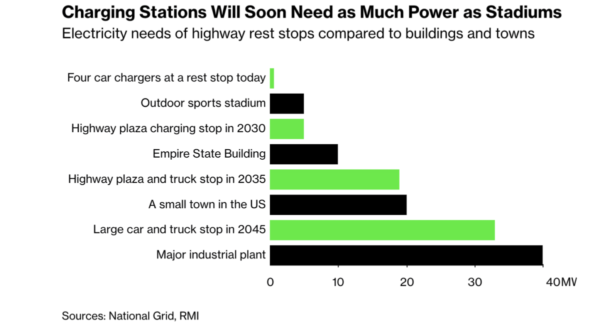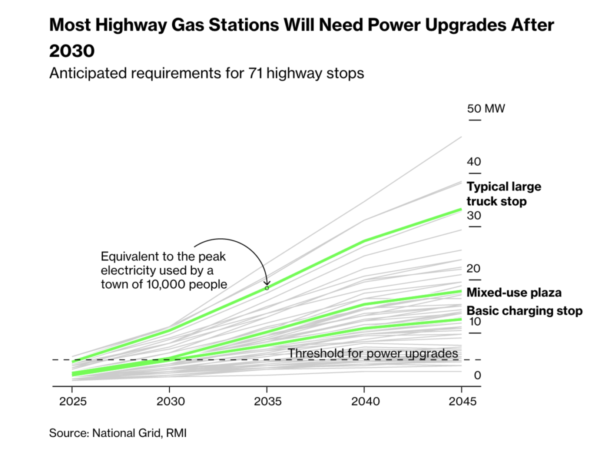Truck stops will soon need the same amount of power as a small town if electrified rigs continue, study shows

A big truck stop will soon require the same amount of power as a small town if electric semi trucks permeate the market as planned, a new study shows.
A new study conducted by National Grid Plc. has found that projected highway charging requirements will skyrocket in the next few years thanks to the introduction of more electrified cars and semi trucks. The study estimates that electrifying a typical highway gas station will require as much power as a professional sports stadium by the year 2030. By 2035, a big truck stop serving electric rigs is expected to require as much power as an entire small town.

Bloomberg reports that even those who conducted the study were surprised by these massive, quickly increasing power demands. Currently, a typical connection to the power grid that can handle more than 5 megawatts (about the demands of an outdoor sports stadium) can take up to eight years to build, and costs tens of millions of dollars.
“We need to start making these investments now,” said Bart Franey, vice president of clean energy development at National Grid in an interview. “We can’t just wait for it to happen, because the market is going to outpace the infrastructure.”
The study also shows that the amount of new electricity needed to power an increase in electric cars and trucks is not the issue, the problem is how quickly the high-speed vehicle chargers will need to deliver electricity at the same place and time.
“It’s not like plugging in a toaster. If you put 50 trucks somewhere, that is basically equivalent to a factory,” said Dave Mullaney, who leads analysis of electric trucking at the RMI energy research institute. “Utilities know how to build factories, but it’s the process and sequencing required that’s scary to me. Utilities need to be starting half a decade ahead of the trucks in order to not be bottlenecking the transition to electric trucks.”

“The number one concern for fleets wanting to electrify all of their vehicles is the infrastructure required,” said Brian Wilkie, director of transport electrification at National Grid. “They know they can’t sell trucks without the power to charge. If they can solve that piece, they can scale the market much more quickly.”
The upcoming Tesla semi truck is the first long-range electric semi truck to hit the market, but even some of the current shorter range rigs are having issues charging. Rakesh Aneja, head of electric trucks at Daimler North America, says that they’ve had multiple customers reconsider an electric truck purchase after learning that it would take over a year longer to have truck chargers installed then it would to receive the trucks themselves.
“Utilities are waiting for a customer application to come in requesting new service before they start their work, and that process is just too long,” Aneja said. “You really have to anticipate that demand and then get started ahead of time. That requires a paradigm shift from a policy and a regulatory perspective.”
More than $1.2 billion in investments have been announced for electric vehicle chargers in 2022 and 2023, which could amount to over 4,000 truck charging points in the US and Europe. However, the focus is expected to remain on electric passenger vehicle charging points for the next few years, even in the face of regulations incentivizing and even requiring the change to electric semi trucks.